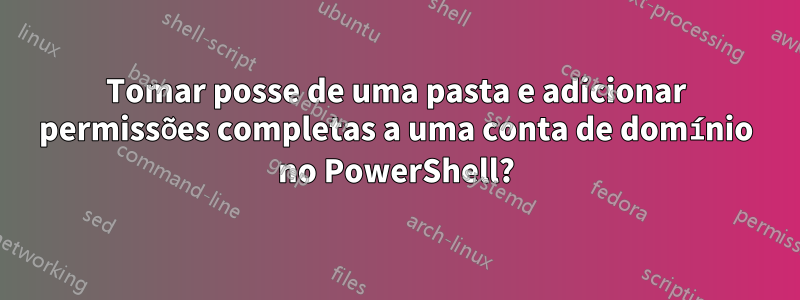
Eu tenho uma função Powershell que faz parte disso, mas ela não usa a conta de domínio para assumir a propriedade e adicionar permissões... ela usa um administrador local. Existe uma maneira melhor de fazer isso no Powershell?
<#
.SYNOPSIS
Take ownership of a folder giving the ownership to ourdomain\myuser
.DESCRIPTION
Takes ownership of a file the way my boss said to do when deleting a user's home directory.
Using the GUI:
1. Right click the folder and select properties.
2. Click the "Security" tab.
3. Click the "Advanced" button.
4. Next to the "Owner:" label, click "Change"
5. Enter ourdomain\myuser
6. Click OK, OK, OK
7. Right click the folder and select properties.
8. Click the "Security" tab.
9. Click the "Advanced" button.
10. Click "Add"
11. Next to "Principal:" click "Select a principal"
12. Enter ourdomain\myuser
13. Click OK
14. Check "Full control"
15. Click OK, OK, OK
16. You should now be able to manipulate or delete the folder.
.NOTES
File Name : Microsoft.PowerShell_profile.ps1
.EXAMPLE
Take-Ownership R:\Redirected\Users\<username>
#>
function Take-Ownership {
param(
[String]$Folder
)
# Take ownership of the folder...
# (though I'd prefer if I could specify a user or group instead)
takeown.exe /A /F $Folder
# Obtain the current ACL for this folder.
$CurrentACL = Get-Acl $Folder
# Add FullControl permissions to the ACL for the user.
Write-Host ...Adding ourdomain\myuser to $Folder -Fore Yellow
$SystemACLPermission = "ourdomain\myuser","FullControl","ContainerInherit,ObjectInherit","None","Allow"
$SystemAccessRule = new-object System.Security.AccessControl.FileSystemAccessRule $SystemACLPermission
$CurrentACL.AddAccessRule($SystemAccessRule)
#Write-Host ...Adding Infrastructure Services to $Folder -Fore Yellow
#$AdminACLPermission = "ourdomain\myuser","FullControl","ContainerInherit,ObjectInherit"."None","Allow"
#$SystemAccessRule = new-object System.Security.AccessControl.FilesystemAccessRule $AdminACLPermission
#$CurrentACL.AddAccessRule($SystemAccessRule)
# Set the ACL again.
Set-Acl -Path $Folder -AclObject $CurrentACL
}
Responder1
Se estiver definindo o proprietário de um objeto para o grupo Administradores, você deverá ser um administrador local. Caso contrário, as pessoas poderiam contornar trivialmente as cotas de disco, já que a contabilização de cotas é baseada na propriedade de arquivos e as cotas não afetam os administradores.
Se você estiver executando o script como administrador, poderá definir o proprietário de um objeto como qualquer entidade de segurança, depois de mexer um pouco. Você precisaráeste script de ajuste de privilégiosde Lee Holmes, que editei ligeiramente para remover espaços em branco extras e permitir que seja executado várias vezes em uma sessão:
param( ## The privilege to adjust. This set is taken from
## http://msdn.microsoft.com/en-us/library/bb530716(VS.85).aspx
[ValidateSet(
"SeAssignPrimaryTokenPrivilege", "SeAuditPrivilege", "SeBackupPrivilege",
"SeChangeNotifyPrivilege", "SeCreateGlobalPrivilege", "SeCreatePagefilePrivilege",
"SeCreatePermanentPrivilege", "SeCreateSymbolicLinkPrivilege", "SeCreateTokenPrivilege",
"SeDebugPrivilege", "SeEnableDelegationPrivilege", "SeImpersonatePrivilege", "SeIncreaseBasePriorityPrivilege",
"SeIncreaseQuotaPrivilege", "SeIncreaseWorkingSetPrivilege", "SeLoadDriverPrivilege",
"SeLockMemoryPrivilege", "SeMachineAccountPrivilege", "SeManageVolumePrivilege",
"SeProfileSingleProcessPrivilege", "SeRelabelPrivilege", "SeRemoteShutdownPrivilege",
"SeRestorePrivilege", "SeSecurityPrivilege", "SeShutdownPrivilege", "SeSyncAgentPrivilege",
"SeSystemEnvironmentPrivilege", "SeSystemProfilePrivilege", "SeSystemtimePrivilege",
"SeTakeOwnershipPrivilege", "SeTcbPrivilege", "SeTimeZonePrivilege", "SeTrustedCredManAccessPrivilege",
"SeUndockPrivilege", "SeUnsolicitedInputPrivilege")]
$Privilege,
## The process on which to adjust the privilege. Defaults to the current process.
$ProcessId = $pid,
## Switch to disable the privilege, rather than enable it.
[Switch] $Disable
)
## Taken from P/Invoke.NET with minor adjustments.
$definition = @'
using System;
using System.Runtime.InteropServices;
public class AdjPriv
{
[DllImport("advapi32.dll", ExactSpelling = true, SetLastError = true)]
internal static extern bool AdjustTokenPrivileges(IntPtr htok, bool disall,
ref TokPriv1Luid newst, int len, IntPtr prev, IntPtr relen);
[DllImport("advapi32.dll", ExactSpelling = true, SetLastError = true)]
internal static extern bool OpenProcessToken(IntPtr h, int acc, ref IntPtr phtok);
[DllImport("advapi32.dll", SetLastError = true)]
internal static extern bool LookupPrivilegeValue(string host, string name, ref long pluid);
[StructLayout(LayoutKind.Sequential, Pack = 1)]
internal struct TokPriv1Luid
{
public int Count;
public long Luid;
public int Attr;
}
internal const int SE_PRIVILEGE_ENABLED = 0x00000002;
internal const int SE_PRIVILEGE_DISABLED = 0x00000000;
internal const int TOKEN_QUERY = 0x00000008;
internal const int TOKEN_ADJUST_PRIVILEGES = 0x00000020;
public static bool EnablePrivilege(long processHandle, string privilege, bool disable)
{
bool retVal;
TokPriv1Luid tp;
IntPtr hproc = new IntPtr(processHandle);
IntPtr htok = IntPtr.Zero;
retVal = OpenProcessToken(hproc, TOKEN_ADJUST_PRIVILEGES | TOKEN_QUERY, ref htok);
tp.Count = 1;
tp.Luid = 0;
if(disable)
{
tp.Attr = SE_PRIVILEGE_DISABLED;
}
else
{
tp.Attr = SE_PRIVILEGE_ENABLED;
}
retVal = LookupPrivilegeValue(null, privilege, ref tp.Luid);
retVal = AdjustTokenPrivileges(htok, false, ref tp, 0, IntPtr.Zero, IntPtr.Zero);
return retVal;
}
}
'@
$processHandle = (Get-Process -id $ProcessId).Handle
try {
Add-Type $definition
} catch {} # Silent failure on re-registration
[AdjPriv]::EnablePrivilege($processHandle, $Privilege, $Disable)
Eu salvei como privs.ps1. Você pode então ligar .\privs.ps1 SeRestorePrivilegepara ativar SeRestorePrivilegeseu processo, o que permite definir a propriedade do arquivo para quem você quiser.
Então, em vez da takeownchamada, você pode usar o objeto ACL que você já possui:
$ownerPrincipal = New-Object System.Security.Principal.NTAccount($newOwnerName)
$CurrentACL.SetOwner($ownerPrincipal)
O novo proprietário será definido ao mesmo tempo que a nova ACL for aplicada.
Finalmente, você pode desabilitar o privilégio extra:
.\privs.ps1 SeRestorePrivilege -Disable


